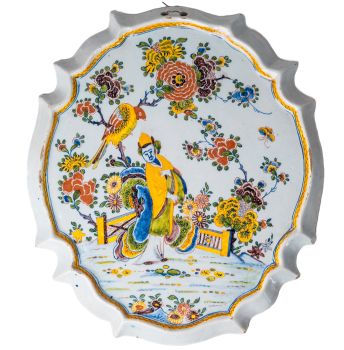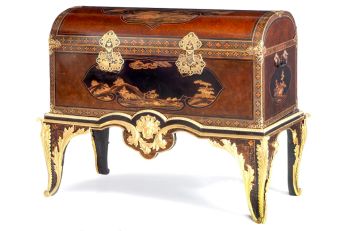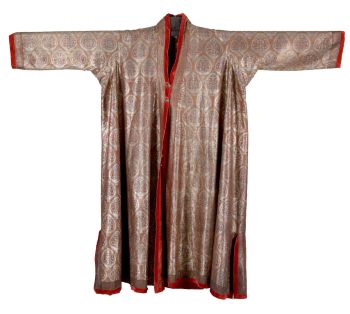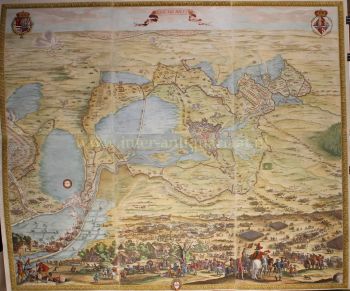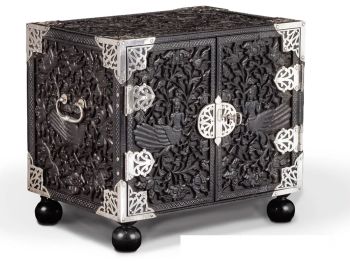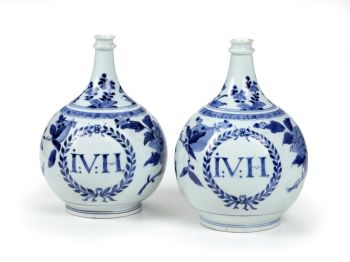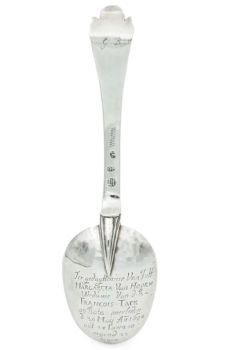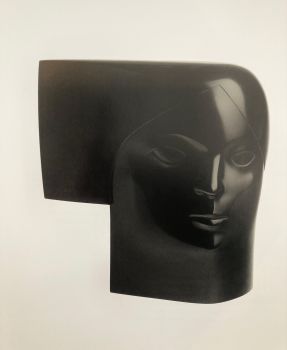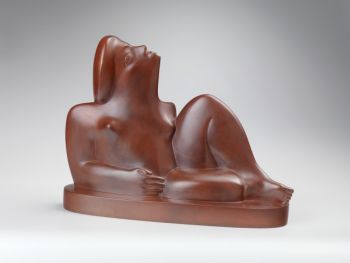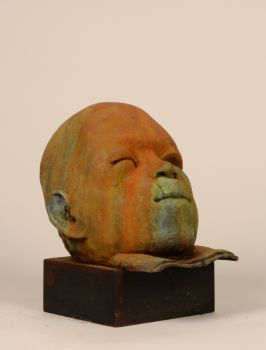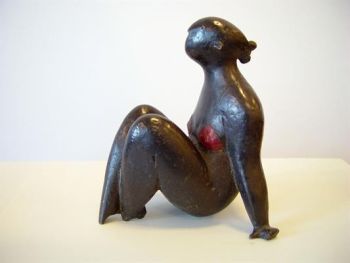A rare Dutch East India Company ‘VOC’ cannon 1764
Unbekannter Künstler
HolzBronzeMetall
80 cm
Derzeit nicht über Gallerease verfügbar
Zebregs & Röell - Fine Art - Antiques
- Über Kunstwerk
Amsterdam, signed and by Pieter Seest, dated 1764 and with Amsterdam town mark
The bronze 1/2-pounder was made for 17-caliber length, and has a later wood gun carriage.
The cannon bears a large VOC monogram and the A for the East India Company Chamber of Amsterdam.
L. 80 cm, grams
Provenance:
Collection H.L.Visser, the Netherlands
Literature:
R. Roth, The Visser Collection - Arms of the Netherlands, in the collection of H.L. Visser, vol II, Zwolle, 1996, cat. no. C37, pp. 138-139 (ill.)
Before the start of the Eighty Years War in 1568, ordinance manufacture was in the Southern Netherlands, particularly in Mechelen, and the Northern Provinces only had a tradition of church bell casting, not of gun founding. However, thanks to migration out of the Southern Netherlands due to Spanish religious intolerance, a large section of the population that had embraced the Protestant faith, including many wealthy entrepreneurs and skilled craftsmen, fled to the North. Cut off from the traditional supply of ordinance, the North, with the help of immigrants from the South, developed their own ordinance.
Already by the early 17th century, Dutch arms and ammunition were major export products to the rest of Europe and abroad. This was fuelled by the expansion of maritime trade through the East and West India Companies, who needed to arm their vast shipping fleets. A religious refugee from the bishopric of Liège, Louis de Geer, together with Walloon iron workers, initiated copper and iron mining and established the Finspång gun foundry in Sweden. Together with Elias Trip, his brother-in-law, a prominent Dutch merchant of guns and financier of the foundry in Sweden, he made Holland the military arsenal of the world, exporting military equipment to most countries in Europe and further afield.
Most guns were made of iron because they were cheaper. However, since iron affects the compasses aboard ships, bronze guns were placed near the helm. - Über Künstler
Es kann vorkommen, dass ein Künstler oder Hersteller unbekannt ist.
Bei einigen Werken ist nicht zu bestimmen, von wem sie hergestellt wurden, oder sie wurden von (einer Gruppe von) Handwerkern hergestellt. Beispiele sind Statuen aus der Antike, Möbel, Spiegel oder Signaturen, die nicht klar oder lesbar sind, aber auch einige Werke sind überhaupt nicht signiert.
Außerdem finden Sie folgende Beschreibung:
•"Zugeschrieben …." Ihrer Meinung nach wohl zumindest teilweise ein Werk des Künstlers
•„Atelier von ….“ oder „Werkstatt von“ Ihrer Meinung nach eine Arbeit, die im Atelier oder in der Werkstatt des Künstlers, möglicherweise unter seiner Aufsicht, ausgeführt wurde
•„Kreis von ….“ Ihrer Meinung nach ein Werk aus der Zeit des Künstlers, das seinen Einfluss zeigt, eng mit dem Künstler verbunden, aber nicht unbedingt sein Schüler
•"Art von …." oder „Anhänger von ….“ Ihrer Meinung nach eine Arbeit, die im Stil des Künstlers ausgeführt wurde, aber nicht unbedingt von einem Schüler; kann zeitgenössisch oder fast zeitgenössisch sein
•„Art von ….“ Ihrer Meinung nach ein Werk im Stil des Künstlers, aber späteren Datums
•"Nach …." Ihrer Meinung nach eine Kopie (jegliches Datums) eines Werks des Künstlers
• „Unterzeichnet …“, „Datiert …“. oder „Beschriftet“ Ihrer Meinung nach wurde das Werk vom Künstler signiert/datiert/beschriftet. Das Hinzufügen eines Fragezeichens weist auf einen Zweifel hin
• „Mit Unterschrift …“, „Mit Datum …“, „Mit Aufschrift ….“ oder „Trägt Unterschrift/Datum/Beschriftung“ ihrer Meinung nach die Unterschrift/Datum/Beschriftung von jemand anderem als dem Künstler hinzugefügt wurde
Sind Sie daran interessiert, dieses Kunstwerk zu kaufen?
Artwork details
Related artworks
- 1 - 4 / 12
Unbekannter Künstler
Japanese transition-style lacquer coffer 1640 - 1650
Preis auf AnfrageZebregs & Röell - Fine Art - Antiques
Unbekannter Künstler
A Dutch colonial Indonesian betel box with gold mounts1750 - 1800
Preis auf AnfrageZebregs & Röell - Fine Art - Antiques
Paulus Franciscus Kromjong
Blumen vor Arearea Aka (Freude) von Gauguin '20th century
Preis auf AnfrageZebregs & Röell - Fine Art - Antiques
Unbekannter Künstler
A Surinam-themed Amsterdam long-case clock1746 - 1756
Preis auf AnfrageZebregs & Röell - Fine Art - Antiques
 Kuratiert von
Kuratiert vonGallerease Magazine
Unbekannter Künstler
EIN UNGEWÖHNLICHES INDONESISCHES SILBERGERICHTlate 17th
Preis auf AnfrageZebregs & Röell - Fine Art - Antiques
1 - 4 / 24Unbekannter Künstler
The bell of the VOC fortress in Jaffna, Sri Lanka1747
Preis auf AnfrageZebregs & Röell - Fine Art - Antiques
 Kuratiert von
Kuratiert vonDanny Bree
1 - 4 / 13Unbekannter Künstler
Holländer in Miniatur (Netsuke)1700 - 1900
Preis auf AnfrageZebregs & Röell - Fine Art - Antiques
Unbekannter Künstler
EIN UNGEWÖHNLICHES INDONESISCHES SILBERGERICHTlate 17th
Preis auf AnfrageZebregs & Röell - Fine Art - Antiques
Unbekannter Künstler
Zwei Studienporträts von Mas Marco Kartodikromo1900 - 1950
Preis auf AnfrageZebregs & Röell - Fine Art - Antiques
Cornelis Anthonisz Theunissen
SEHR SELTENE ERSTE GEDRUCKTE KARTE VON AMSTERDAM, EINER STADT AUF DEM AUFSTIEG1544
€ 175.000Inter-Antiquariaat Mefferdt & De Jonge
 Kuratiert von
Kuratiert vonDanny Bree
Unbekannter Künstler
EINE SAMMLUNG VON VIER SRI LANKAN IVORY BIBELKÄSTCHEN18th century
Preis auf AnfrageZebregs & Röell - Fine Art - Antiques
Unbekannter Künstler
A silver spoon commemorating Juff’ Margareta van Hoorn1656 - 1694
Preis auf AnfrageZebregs & Röell - Fine Art - Antiques
1 - 4 / 24- 1 - 4 / 24
 Kuratiert von
Kuratiert vonDanny Bree
Unbekannter Künstler
A large Japanese Imari porcelain 'VOC Groningen' dish1800 - 1925
Preis auf AnfrageZebregs & Röell - Fine Art - Antiques
Unbekannter Künstler
EIN UNGEWÖHNLICHES INDONESISCHES SILBERGERICHTlate 17th
Preis auf AnfrageZebregs & Röell - Fine Art - Antiques
1 - 4 / 12








